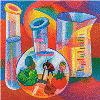Chemical and Biomolecular Engineering Research and Publications
Date of this Version
July 1999
Abstract
To test for tumour necrosis-like factor (TNF) of chickens, supernatants of a lipopolysaccharide (LPS)-stimulated chicken macrophage cell line MQ-NCSU were analysed. A sequence of ion-exchange and gel-permeation chromatography was utilised to isolate TNF-like activity from the culture supernatant. The peak of TNF-like cytotoxic activity corresponded to the fractions with a nlolecular weight of 81 kDa or higher. Polyclonal anti-human TNF-a antiserum cross-reacted by Western blotting with a 17 kDa protein in the TNF-containing fraction ~ ~ n d e denaturing conditions. This result indicated that chicken TNF-like factor in the biologically active form may be a protein multimer of monomers of about 17 kDa. The molecular weight of these monomers is similar to the molecular weight of mammalian TNF-CLC. hicken TNF-like factor stimulated macrophages by inducing morphological changes, enhancing Ia-expression, nitric oxide (NO) production and by synergising with interferon (1FN)-y in the induction of NO release from macrophages. The biological activities were not neutralised by anti-human TNF antiserum. These data suggest that LPS-stimulated chicken macrophages produced a functional homologue to mammalian TNF-CL. This may be structurally quite different from the mammalian TNF molecule. Other factors may have been co-purified with the chicken TNF-like factor having overlapping functions and molecular weight. However, CO-purification of chemokines and interleukin-l, major macrophage derived factors, with the chicken TNF-like factor can be excluded based on the purification strategies.



Comments
This article was Published in Developmental and Comparative Immunology 23 (1999) 629-640.© 1999 Elsevier Science Ltd. For published vesrion of theis article please visit publishers site